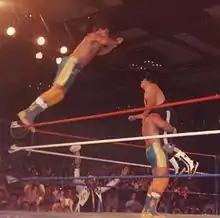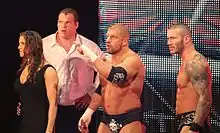Glossary of professional wrestling terms
Professional wrestling has accrued a considerable amount of jargon throughout its existence.[1][2] Much of it stems from the industry's origins in the days of carnivals and circuses.[3] In the past, professional wrestlers used such terms in the presence of fans so as not to reveal the worked nature of the business.[1][3] In recent years, widespread discussion on the Internet has popularized these terms.[1] Many of the terms refer to the financial aspects of professional wrestling in addition to in-ring terms.[3]
A
B

C
A point in a match in which the heel stops the face's attack or comeback and goes on the offensive.[2]
D

E

Also lackey or heavy
A (typically larger) wrestler who accompanies another wrestler as a second to matches and acts as a bodyguard.[1]F
A brief offensive flurry by a face, before losing momentum back to a heel after being dominated for several minutes.[1] Usually, it occurs before the actual comeback.
G

H

I
J
K
L
M



N
O
P


R

A loud roar of approval that a wrestler receives from the fans when making their entrance to the ring, in reference to one of the most iconic and idolized tag teams in WWE history, the Road Warriors, also known as, Legion of Doom.

S


T

U
V
W
X
Y
Z
References
- "Torch Glossary of Insider Terms". PWTorch.com. 2000. Archived from the original on June 6, 2011. Retrieved July 10, 2007.
- Shoemaker, David (August 13, 2014). "Grantland Dictionary: Pro Wrestling Edition". Grantland. Retrieved November 11, 2019.
- Kerrick, George E. (Summer 1980). "The Jargon of Professional Wrestling". American Speech. 55 (2): 142–145. doi:10.2307/3050508. JSTOR 3050508.
- Caldwell, James (April 1, 2015). "ROH news: New Japan's top star announced for ROH vs. New Japan tour, ROH releases "Field of Honor" details". Pro Wrestling Torch. Retrieved June 11, 2016.
- 全日諏訪魔VS大日関本シングル対決実現. Nikkan Sports (in Japanese). December 19, 2011. Retrieved June 11, 2016.
- Nicholas Sammond, Steel Chair to the Head: The Pleasure and Pain of Professional Wrestling (2004).
- Riley, Judge William F. (October 15, 1956). "United States v. National Wrestling Alliance (consent decree)". United States District Court for the Southern District of Iowa. As hosted at Wrestling Perspective. Retrieved September 17, 2011.
- "Celebrate TakeOver 25 With The Best GIFs From The 25 NXT Live Specials". May 30, 2019.
- "Joey Janela's Spring Break 3 Part One Recap: Deathmatch, Jungle Boy Returns, Virgil Appears". Wrestling Inc. April 6, 2019.
- "OSW Dictionary".
- Segarra, Jason. "WWE No Mercy 2017 review: A good run that stumbles before the goal line".
- "SHIMMER 62 live results: Cheerleader Melissa defends against LuFisto". April 5, 2014.
- http://www.acrossthepondwrestling.co.uk/2016/10/event-review-fcp-breaking-into-heaven.html
- Foley, Mick. Have A Nice Day: A Tale of Blood and Sweatsocks (p.65)
- Ross, Jim (May 5, 2015). "Samoa Joe on Ross Report podcast tonight". JR's BarBQ. Retrieved July 30, 2016.
- Clapp, John (February 17, 2013). "WWE Champion The Rock def. CM Punk". WWE. Archived from the original on February 21, 2013. Retrieved July 30, 2016.CS1 maint: bot: original URL status unknown (link)
- Whatever Happened to Gorgeous George by Joe Jares, Tempo Books, 1974, p. 85.
- Harley Race, Ricky Steamboat, Les Thatcher. The Professional Wrestlers' Workout & Instructional Guide (p.106)
- Stone Cold Steve Austin. The Stone Cold Truth (p.90)
- Stone Cold Steve Austin. The Stone Cold Truth (p.83)
- "Wrestling Booker's Glossary of pro wrestling terms". Archived from the original on June 13, 2008. Retrieved April 11, 2008.
- "Orange Cassidy Kid Pins Cody After AEW Dynamite Tapings (Video), AEW Renames Go Position In Honor Of Dusty Rhodes". Wrestlezone. October 17, 2019.
- "5 Wrestling moves banned by WWE". FOX Sports. December 20, 2018. Retrieved January 9, 2020.
- "Grantland Dictionary: Pro Wrestling Edition". grantland.com. August 13, 2014. Retrieved October 24, 2014.
- Rueter, Sean. "Are you a Mark?". Cageside Seats. Vox Media. Retrieved 25 July 2020.
- Seagull, Justin (July 16, 2017). "10 Biggest "Jannettys" In Wrestling History". WhatCulture.com.
- "Pro Wrestling Primer: Glossary of terms". The Evil Eye Blog. 2009. Retrieved December 7, 2014.
- Mancuso, Ryan (September 11, 2006). "Complete Playbook: The Great Muta Vol. 2 Revenge of Muta Commercial Tape". 411mania.com. Retrieved October 24, 2007.
- Cory Kilgannon (March 15, 2012). "From Inside a Bad-Guy Wrestler, a Brutal Artist Screamed for Release". The New York Times. Retrieved January 14, 2016.
- "Young WWE fan Nicholas teams with Braun Strowman against The Bar". YouTube. WWE. April 8, 2018. Retrieved April 9, 2018.
- "WWE WrestleMania 34 results: Braun Strowman picks 10 year old WWE fan 'Nicholas' as mystery partner". Forbes. Retrieved 9 April 2018.
- Illuminati, Chris (February 23, 2017). "The Slow Death of the Great Professional Wrestling Promo".
- John Powell (June 18, 2000). "Booker T: Wrestling's consummate performer". SLAM! Wrestling. Retrieved 2008-06-17.
- Laurer, Joanie. If They Only Knew. pp. 192–193.
- Ross, Jim; J.R.'s Family Bar-B-Q® (December 24, 2013). "#RAW Christmas Feedback..." J.R.'s Place blog. Retrieved December 25, 2013.
- "AAA Triplemania 2017 today, complete lineup". Pro Wrestling Insider. Retrieved 18 December 2017.
- X-Pac on: Yokozuna. YouTube. 31 December 2014.
- Kaelberer, Angie Peterson (2003). The Hardy Boyz: Pro Wrestlers Matt and Jeff Hardy. Capstone Press. p. 44. ISBN 0-7368-2142-2.
- Khan, Steve. "Examining Dean Ambrose's roller coaster ride to the top of WWE". Wrestling Observer. Retrieved 18 July 2017.
- "The Shield vs. The Wyatt Family: Tale of the Tape". WWE. Retrieved June 29, 2016.
- Sammond, Nicholas (2005). Steel Chair to the Head: The Pleasure and Pain of Professional Wrestling. Duke University Press. pp. 211–212. ISBN 0-8223-8682-8.
- "The nWo". Legends of Wrestling. Season 1. Episode 28. 1 July 2011. 2 minutes in. Classics on Demand. WWE.
- "Heart to Hart: 90 Minutes on the Phone with Bret 'The Hitman' Hart". offthetracks.co.nz.
- Beaston, Erik (17 April 2016). "10 Greatest Wrestling Technicians In WWE History". WhatCulture.com.
- Jeff Clark (September 7, 2007). "The Luchagors Drop a Powerbomb". Stomp and Stammer. Retrieved 2007-10-02.
- The Masked Man (David Shoemaker) (June 28, 2011). "Punk'd". Grantland. Archived from the original on January 21, 2013.
- "WWE Network – Tales From the Deadman" – via watch.wwe.com.
- "What is "X-Pac heat"?". Reference.com.
Sources
- Beekman, Scott. Ringside: A history of professional wrestling in America (Greenwood, 2006)
- Foley, Mick (2000). Have a Nice Day: A Tale of Blood and Sweatsocks. HarperCollins. ISBN 0-06-103101-1.
- Harley Race; Ricky Steamboat; Les Thatcher (2005). The Professional Wrestlers' Workout & Instructional Guide. Sports Publishing LLC. ISBN 1-58261-947-6.
- Kerrick, George E. "The jargon of professional wrestling". American Speech (1980): 142–145. JSTOR
- Laurer, Joanie (2001). If They Only Knew. ReaganBooks. ISBN 0-06-109895-7.
- Mazer, Sharon. Professional wrestling: sport and spectacle (Univ. Press of Mississippi, 1998)
- Murray, Thomas E. "The language of bodybuilding". American Speech (1984): 195–206. in JSTOR
- Stone Cold Steve Austin; Jim Ross (2003). The Stone Cold Truth. Pocket Books. ISBN 0-7434-7720-0.
External links
- Total Wrestling Terms
- Wrestling Booker's Glossary of pro wrestling terms at the Wayback Machine (archived June 13, 2008)